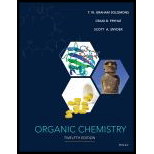
Concept explainers
Interpretation:
Different isomers with chemical formula
Concept introduction:
Isomers are compounds that have similar chemical formulas but different structures. They have similar molar weights and also have the same composition of elements both qualitatively and quantitatively.
Fractional distillation is the process of separation of a mixture into its components or fractions.
Enantiomers are the stereoisomers that are non-superimposable mirror images of each other.
Isomers that possess chiral centers and have a plane of symmetry are optically inactive.
Want to see the full answer?
Check out a sample textbook solution
Chapter 10 Solutions
EBK ORGANIC CHEMISTRY
- Reaction of -pinene with borane followed by treatment of the resulting trialkylborane with alkaline hydrogen peroxide gives the following alcohol. Of the four possible cis,trans isomers, one is formed in over 85% yield. (a) Draw structural formulas for the four possible cis,trans isomers of the bicyclic alcohol. (b) Which is the structure of the isomer formed in 85% yield? How do you account for its formation? Create a model to help you make this prediction.arrow_forwardplease drawarrow_forwardHow can the following conversions be carried out (i) Aniline to bromobenzene (ii) Chlorobenzene to 2-chloroacetephenane (iii) Chloroethane to butane.arrow_forward
- Mention and Write the following reaction mechanisms: a) thermal dehydration of 4-t-butylcyclohexanol with phosphoric acid as catalyst; b) addition of molecular bromine to the C= C double bond of 4-t- butylcyclohexene;arrow_forwardAn unknown hydrocarbon G, whose formula is C16H26 contains two triple bonds. Ozonolysis followed by reduction with (CH3)2S gave CH3(CH2)4CO2H and HO2CCH2CH2CO2H as the only products. Suggest a reasonable structure for compound G.arrow_forwardGive detailed Solution with explanationarrow_forward
- Q9:- Outline a possible laboratory, synthesis of each of the following compounds from benzene and/or toluene, using any needed aliphatic and inorganic reagents, (a) m-bromophenol (b) 5-bromo-2-methylphenol Q10:- Explain how Esters are more reactive than amides in nucleophilic acyl substitution reactions.arrow_forwardGive a clear handwritten answer with explanationarrow_forwardGive reasons: (a) n-Butyl bromide has higher boiling point than f-butyl bromide. (b) Racemic mixture is optically inactive. (c) The presence of nitro group (-N02) at o/p positions increases the reactivity of haloarenes towards nucleophilic substitution reactionsarrow_forward
- (a) Tsomane and Nyiko were given a task of synthesising methylenecyclohexane 2. After a brief discussion with each other, Tsomane proposed Method A to synthesise 2 from cyclohexanone 1 while Nyiko proposed Method B that started from hydroxymethylcyclohexane 3. Each student believed that their proposed method is better than the other. (Scheme below) (1) Ph Ph 8*8 Ph THF A 1 Santande B H₂SO4 100 °C 3 OH Using curly arrows, provide full mechanistic details accounting how methylenecyclohexane 2 was synthesised according to both Methods A and B.arrow_forwardHydrocarbon A, C9H12 absorbs 3 equiv. of hydrogen to give B, C9H18 when hydrogenated over a Pd/C catalyst. Treatment of A with aqueous H2SO4 and Hg(II) gives two isomeric ketones, C & D. Oxidation of A with KMnO4 gives acetic acid and the tricarboxylic acid E shown below. Propose a structure for A.arrow_forwardQ2(17 Marks): outline all steps in a possible laboratory synthesis of the following compounds: ( using any inorganic or organic reagents): a) 2-butyne from ethane b) 2-methyl-4-chlorosulphonic acid from benzene c) trans-1,2-dibromocyclohexane from cyclohexane d) 4-bromo-3-chlorobenzoic acid from benzenearrow_forward
 Organic ChemistryChemistryISBN:9781305580350Author:William H. Brown, Brent L. Iverson, Eric Anslyn, Christopher S. FootePublisher:Cengage Learning
Organic ChemistryChemistryISBN:9781305580350Author:William H. Brown, Brent L. Iverson, Eric Anslyn, Christopher S. FootePublisher:Cengage Learning
